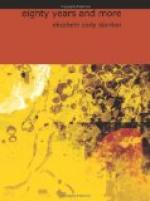However, in spite of all our own experiences and of all the warning words of wisdom from those who had seen life in its many phases, we entered the charmed circle at last, all but one marrying into the legal profession, with its odious statute laws and infamous decisions. And this, after reading Blackstone, Kent, and Story, and thoroughly understanding the status of the wife under the old common law of England, which was in force at that time in most of the States of the Union.
CHAPTER IV.
Life at Peterboro.
The year, with us, was never considered complete without a visit to Peterboro, N.Y., the home of Gerrit Smith. Though he was a reformer and was very radical in many of his ideas, yet, being a man of broad sympathies, culture, wealth, and position, he drew around him many friends of the most conservative opinions. He was a man of fine presence, rare physical beauty, most affable and courteous in manner, and his hospitalities were generous to an extreme, and dispensed to all classes of society.
Every year representatives from the Oneida tribe of Indians visited him. His father had early purchased of them large tracts of land, and there was a tradition among them that, as an equivalent for the good bargains of the father, they had a right to the son’s hospitality, with annual gifts of clothing and provisions. The slaves, too, had heard of Gerrit Smith, the abolitionist, and of Peterboro as one of the safe points en route for Canada. His mansion was, in fact, one of the stations on the “underground railroad” for slaves escaping from bondage. Hence they, too, felt that they had a right to a place under his protecting roof. On such occasions the barn and the kitchen floor were utilized as chambers for the black man from the southern plantation and the red man from his home in the forest.
The spacious home was always enlivened with choice society from every part of the country. There one would meet members of the families of the old Dutch aristocracy, the Van Rensselaers, the Van Vechtens, the Schuylers, the Livingstons, the Bleeckers, the Brinkerhoffs, the Ten Eycks, the Millers, the Seymours, the Cochranes, the Biddles, the Barclays, the Wendells, and many others.
As the lady of the house, Ann Carroll Fitzhugh, was the daughter of a wealthy slaveholder of Maryland, many agreeable Southerners were often among the guests. Our immediate family relatives were well represented by General John Cochrane and his sisters, General Baird and his wife from West Point, the Fitzhughs from Oswego and Geneseo, the Backuses and Tallmans from Rochester, and the Swifts from Geneva. Here one was sure to meet scholars, philosophers, philanthropists, judges, bishops, clergymen, and statesmen.




